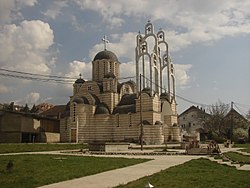Top Qs
Timeline
Chat
Perspective
Leposavić
Town and municipality in Mitrovica, Kosovo From Wikipedia, the free encyclopedia
Remove ads
Leposavić (Serbian Cyrillic: Лепосавић, pronounced [lɛ̌pɔsaʋitɕ]), also known as Leposaviq or Albanik[2] (Albanian definite form: Leposaviqi or Albaniku), is a town and the northernmost municipality in the Mitrovica District in Kosovo. As of 2015, it has an estimated population of 18,600 inhabitants.[3] The municipality covers an area of 539 km2 (208 sq mi) which makes it the fifth largest in Kosovo, and consists of the town and 72 villages.
It is a part of North Kosovo, a region with an ethnic Serb majority. As per the 2013 Brussels Agreement, the municipality is expected to become part of a proposed Community of Serb Municipalities.
Remove ads
Name
Although historically known as Leposavić in Serbian and Leposaviq in Albanian and being an area of Serbian settlement, the town has been referred to as Albanik on some maps produced by KFOR since Kosovo's declaration of independence.[4] Albanik is preferred over Leposaviq in Kosovar governmental documents translated into English.[5]
History
Summarize
Perspective
From 1877 to 1913 Leposavić was part of Kosovo vilayet. Leposavić, then a village, was the scene of fighting during the Serbian–Turkish Wars from 1876-1878.[6]
Yugoslavia (1918–92)
After the First Balkan War (1912), Kosovo was internationally recognised as a part of Serbia and northern Metohija as a part of Montenegro at the Treaty of London in May 1913. In 1918, the Kingdom of Serbs, Croats and Slovenes, later named Yugoslavia was established by the merging of the Western South Slavic states. Between 1929 and 1941, the region was administratively part of the Zeta Banovina.
Lešak, Belo Brdo, Vračevo, Berberište were incorporated into the Leposavić municipality in 1953.[citation needed]
In the mid–1950s, the Assembly of PR Serbia decided that the Leposavić municipality be ceded to Autonomous Region of Kosovo and Metohija, after requests by the Kosovo leadership.[7] It had up until then been part of the Kraljevo srez, of which the population was wholly Serb.[7] After this, the number of Serbs drastically fell.[7] In 1959, Leposavić was incorporated into the province.[8][9]
Modern
After the NATO bombing of Yugoslavia, the political group Pokret za Leposavić ("Movement for Leposavić") was established, which sought to bring together those committed to cooperation and communication with the international community and the Albanians.[10]
Remove ads
Settlements
Aside from the town of Leposavić, the municipality includes the following villages:
- Bare
- Belo Brdo
- Beluće
- Berberište
- Bistrica
- Bistrica e Shalës
- Borova
- Borčane
- Brzance
- Cerajë
- Crveni
- Crnatovo
- Ćirkoviće
- Desetak
- Dobrava
- Donje Isevo
- Donji Krnjin
- Dren
- Duboka
- Gnježdane
- Gornji Krnjin
- Graničane
- Grkaje
- Guvnište
- Gulije
- Ibarsko Postenje
- Jarinje
- Jelakce
- Jošanica
- Kajkovo
- Kamenica
- Kijevčiće
- Koporiće
- Kostin Potok
- Košutica
- Košutovo
- Kruševo
- Kruščica
- Kutnje
- Lazine
- Leshak
- Lozno
- Majdevo
- Mekiniće
- Miokoviće
- Mioliće
- Mošnica
- Ostraće
- Plakaonica
- Planinica
- Popovce
- Potkomlje
- Pridvorica
- Rvatska
- Rodelj
- Rucmance
- Seoce
- Slatina
- Sočanica
- Tvrđan
- Trebiće
- Trikose
- Ulije
- Vitanoviće
- Vračevo
- Vuča
- Zabrđe
- Zavrata
- Zemanica
- Zrnosek
Demographics
According to the 2011 estimations by the Government of Kosovo, Leposavić has 4,193 households and 13,773 inhabitants.[11] In 2015 report by OSCE, the population of Leposavić municipality stands at 18,600 inhabitants.[3] The municipality of Leposavić includes the town and 72 villages.
Ethnic groups
The majority of Leposavić municipality is composed of Kosovo Serbs with around 18,000 inhabitants (96.4%), while 350 Bosniaks and 270 Kosovo Albanians live in the municipality.[3] Kosovo Albanians live in the three southern villages of Bistrica e Shalës, Cerajë, and Koshutova.
The ethnic composition of the municipality of Leposavić, including IDPs:[3]
Remove ads
Economy
Almost all industrial facilities are closed or work with reduced capacity. The unemployment rate is also high, and it has been considerably increased due to the closing down of most of the Trepča conglomerate facilities. The municipality is rich in natural, infrastructure and management, but current circumstances blocked all the potentials. The municipality adopted the Development Agenda 2006 – 2009, in cooperation with United Nations Office for Project Services and with the support of UNMIK and the Italian Government, which foresees improvement in the local economy. However, with the current difficult situation, there is not much hope that the agenda will be properly implemented. The municipality, led by a very proactive chief executive officer, pays noteworthy efforts toward identifying and initiating projects ideas.[3]
There are three lead and zinc mines operating on the territory of Leposavić: Belo Brdo, Crepulje and Crnac.
The NGO Caritas Kosovo maintains a regional office in Leposavić.[12]
Remove ads
Cultural monuments
The municipality has several monuments protected by the Republic of Serbia as part of the cultural heritage list.
The following Serbian Orthodox churches are located in Leposavić:
- Sočanica Monastery
- Vračevo Monastery
- Church of Cosmas and Damian
- Church of St. Basil of Ostrog
Gallery
- Church of Cosmas and Damian
- Monastery of Vračevo
- Church of St. Basil of Ostrog
- Church of St. Basil of Ostrog
See also
References
Sources
External links
Wikiwand - on
Seamless Wikipedia browsing. On steroids.
Remove ads








